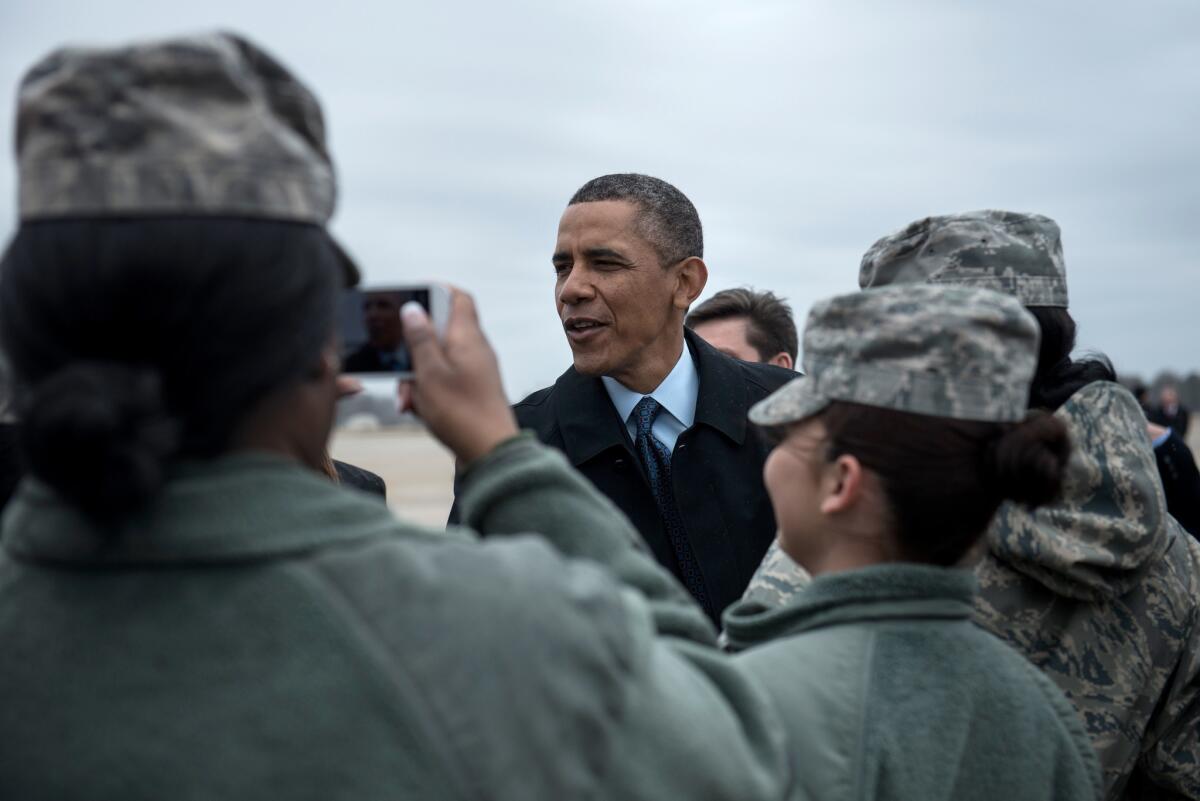Obama’s dangerous defense experiment

- Share via
Mindful of the repeated rounds of cuts the military has already endured, Gen. Martin Dempsey, chairman of the Joint Chiefs, recently delivered a grim warning: “If you want [the military] to be doing what it’s doing today, then we can’t give you another dollar.”
His worries reflect reductions that started in 2009 and have reached crippling levels, even in President Obama’s proposals to avert sequestration. I take the general at his word, but I am concerned that the president does not.
Sequester hurts national security, not just because 50% of the cuts fall on the military’s 18% share of the overall budget but because the Pentagon has been the only place the president is willing to cut. For four years he has mismanaged our nation’s most vital resource, our uniformed military, fomenting the sequester-inspired readiness crisis it faces today. His actions, his under-resourced strategies, accelerated withdrawal plans and lead-from-behind policies have left the Pentagon far less able to shoulder the burden of another 10% cut.
The wide swath of missions Dempsey referred to benefit Americans in varied ways. Some are obvious, like fighting terrorism; some are subtler, like patrolling our airspace and shoring up our economic security by keeping vital avenues of commerce free — on the seas and in space and cyberspace.
Those are missions the military should be able to perform without putting undue stress on the armed services as a whole. Actually, I want them to be fully prepared if they are called on to do much more. While there is no question the Pentagon was long overdue for a housecleaning, we have cut down so rapidly and so blindly that we’re in danger of breaking the back of the force.
And, perhaps more important, the sequester will cripple our military’s ability to fulfill its primary role: to keep this nation out of war.
Already, Pentagon planners are going through the laundry list of missions that could be cut. The Navy has been forced to keep a carrier in port rather than send it on a scheduled deployment to the Middle East. That message is not lost on the Iranians.
Sequestration manifests itself in less prominent but no less potent ways. For example, tons of illegal narcotics are intercepted annually by military patrols in the Caribbean. The Navy is now shuttering operations that will leave the door open for those drugs to find their way to America’s suburbs. The Navy may also have to curtail its ballistic missile defense patrols — even as North Korea successfully launched a missile into space in December and conducted a nuclear test in recent weeks.
The Air Force will be hit so hard, its leadership is being forced to cut flight hours for air crews. If they cannot train adequately enough to deploy, our pilots may well be grounded during the next national crisis.
The Marine Corps faces an equally dire outlook, where cuts are so deep we risk losing the Marines as a deployable force. Adm. Jonathan Greenert, chief of naval operations, warned in congressional testimony that because there will be no amphibious ready group around Africa, the Marines can no longer provide quick-reaction support to our embassies there. The next time America needs to call 911, we may not be able to call in the Marines.
The Army faces similar challenges, as do the industries that support the Defense Department.
In California alone, it is estimated that we could lose 126,000 private sector jobs, 20,000 active-duty military jobs and more than 15,000 civilian Defense Department jobs. I have spent the last year and a half talking with my constituents who will be directly affected by these cuts. It is unbelievable that the president would support a plan that would dissolve a highly skilled and dedicated workforce at installations such as the Antelope Valley’s Plant 42. Remember, many workers in California and across the nation have lost their jobs because of previous dramatic defense cuts. Sequester only adds to this pain.
That brings us to a choice. If there were a proposal on the table that spared the troops and heeded Dempsey’s warning of not a dollar more from the armed forces, I would ask House Speaker John A. Boehner (R-Ohio) to consider it. But after cutting defense three times, the president’s solution to replacing sequester means another $250 billion out of the armed forces and more taxes. The choice the American people are being given is “break the military” or “break the military and new taxes.”
Let’s be clear: Even if the president were given every dollar in new taxes he has requested, it wouldn’t make a difference in our national debt. Entitlement programs will continue to grow out of control, and the amount we spend on interest to service the debt soon will start to outpace even what we spend on the military. The cuts he continues to insist on, while below the level of sequestration, are still severe enough to hollow out our force. This approach forces me to conclude that the president, for all his stump speeches and props, wants the sequester to happen.
The president is forcing America to indulge him in this dangerous experiment with national security. It is unworthy of the sacrifice of the hundreds of thousands in uniform whom he has directed into harm’s way over the last four years. It is a reckless experiment when one takes stock of the growing threats and commitments that occupy our forces around the world.
Rep. Howard P. “Buck” McKeon (R-Santa Clarita) is chairman of the House Armed Services Committee.
More to Read
A cure for the common opinion
Get thought-provoking perspectives with our weekly newsletter.
You may occasionally receive promotional content from the Los Angeles Times.










